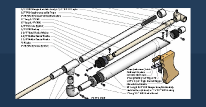It needs a lot of ergonomic work (See bottom of post for current status) , but it reliably fires through a hopper, and has 3 firing modes.
The hopper fires in single and slam-fire mode, while the lever doubles as a catapult that fires stock ammo or
whatever farther than most of Nerf's pre-elite / pre-vortex line of blasters.
Ranges are unknown, but seem on par with my other blasters.
This is the 7-11 unprimed:

This is the 7-11 primed

The function of this blaster, if we ignore the lever / air cylinder for a time, is very similar to 3dBBQ's
airguns. When the tank has air, the positive pressure holds a PVC check valve closed until a stick pushes it open.
The only difference there is that 3dBBQs used O-rings to seal, and mine uses an oilite bushing.
Really this is a matter of taste. Everything past from the check valve, including trigger, to the end of the barrel only needs
to seal as well as a springer, as it's only exposed to pressurized air at the moment of firing.
Other than that everything past the check valve is conceptually the same (although the plumbing is in a different shape).

The size of the "pump", for which I used a 1.5" x 6" Bimba air cylinder from McMaster, gives enough volume to fire with
one stroke, but the traditional airgun analogy breaks down here, because there is no check-valve between the pump and
the tank-the remaining stroke in the air cylinder merely adds to the size of the tank. If you tried to prime / pump this
blaster directly with the air cylinder (no lever), you would not only find that it requires a great deal of strength, but it
also wouldn't stay "pumped", as the air would just push the cylinder piston back. The lever is the magical piece that
sets the 7-11 apart from traditional airguns, because it uses the pushback force from the air cylinder to lock it in place.
Furthermore, the lack of checkvalve ensures that IT IS IMPOSSIBLE TO PUT MORE THAN 1 "PUMP"'s WORTH OF AIR INTO THE TANK.
Unlike an airgun with an OPRV, the intrinsic safety of this blaster is that it cannot be overpumped by speed or by sabotage.
The basic mechanism of the lever and how it pumps the cylinder should be clear from the primed and unprimed pictures at the start,
but the locking mechanism may need some explanation. Basically, the direction the lever is pushed by the force from the
air in the cylinder depends on the orientation of the lever linkage. In one direction, it travels about 60 degrees, but in
the other, only a few degrees. The latter, smaller travel is the lock zone, because the lever is being pushed against a stop
(in this case, the 1.5" PVC frame of the blaster). The diagram below should give you an idea of how this works:

These are the measurements of the plates I used for the aforementioned lever mechanism. I planned to use 2 of the triangle pieces, but wound up with just one. The triangle piece is triangular to that I can attach a long lever arm to it more easily.

My ergonomic intent with this is to get something like the buzzbee rapid-fire-rifle, pictured below with my current tape-job / replumbing.
The priming-hand is the trigger hand, which can work because the trigger is at the end of the priming stroke. The other hand
just goes in front of the lever linkage, which is farther away than I'd like. With cleverly shaped linkages, I could change
this so that there is a place for the hand underneath the lever mechanism without getting pinched.

Materials:
1.5" x 6" Air Cylinder
1/8" NPT to 3/8" Barb adapter
8" 3/8" x 5/8" Hose
5/8" Hose Clamps
3/8" Barb to 1/2" NPT adapter
1/2" NPT to 3/4" NPT adapter
3/4" NPT to 1/2" socket adapter
1/2" PVC Check valve
2x PVC Wye
1/4" x 3/8" Flanged Oilite Bronze Bushing
3d printed bushing holder / dead space reducer
2x 3d printed hingepiece
3/8" HDPE Sheet
TODO:
Trigger pad
Trigger return spring
Trigger out limit
Front handle for non priming hand
Rear handrest for priming hand / priming rod
Hole in frame tube to allow a farther past-center prime.
Graph of linear prime force vs linear displacement
Graph of linear displacement vs angular displacement
Graph of linear prime force vs angular prime force
Graph of angular prime force vs displacement
Design more elegant plumbing for future models
Learn how to make plungers that seal perfectly and not buy any more air cylinders
Actual instructions
Edited by KaneTheMediocre, 13 July 2013 - 10:27 PM.



















